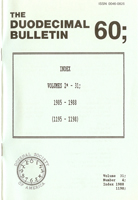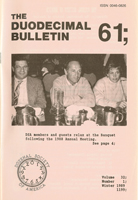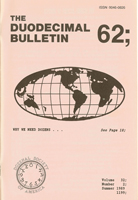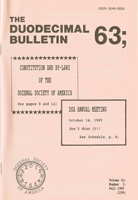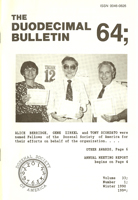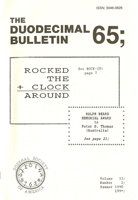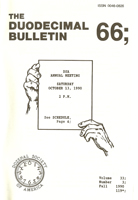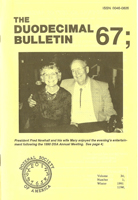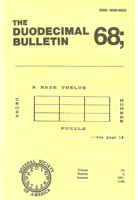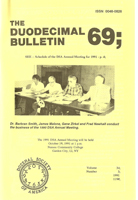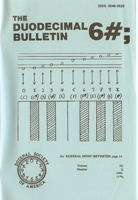The Dozenal Society of America
The DSA is a voluntary, nonprofit education
corporation, organized for the conduct of
research and education of the public in the
use of dozenal (also called duodecimal or
base-twelve) in calculations, mathematics,
weights and measures, and other branches of
pure and applied science.
Questioning with a Smile as the World Wakes up from History
As the Berlin Wall comes down and the Cold War world
melts away, the Dozenal Society of America continues in
its peaceful examination and exposition of the qualities
of base twelve. Dr. Impagliazzo explores music and the
dozen, a topic John D. Hansen, Jr. returns to later. The
long hundred, conveyed twice by Jens Ulff-Møller,
PhD., fascinates those gathered at Nassau Community
College in 1991 and 1992. Gene Zirkel’s “Binary Coded
Digits”, describing Bill Schumacher’s seven-segment
digits, thrills Don Hammond across the pond, and
like-minded dozenalist fans of the LCD display-style
numerals. Mr. Charles Trigg passes away, yet leaves a
legacy of articles published postmortem which celebrate
dozenal recreational mathematics. Mr. Churchman’s 1975
summation of his “metronic” system of weights and
measure finally appears in Vol. 34; No. 3. The Society
continues to meet annually, and Dozenal Jottings continue
to pour in. The sustained dozenal “peace”, the eager
questioning with a smile, continues into the nineties.
Bulletin Index Vols. 2X-31
Index addenda; Paquette’s dozenal essay; Dr. Rapoport’s dozenal computer quiz
Schiffman’s “Fundamental Operations”, part 2; “10;0 = One Dozen”; The communication age
DSA Constitution and By-Laws; Trigg obituary; “2B or not 2B”
P. D. Thomas; Newhall’s “Nu-Age Calendar”; Dr. Impagliazzo’s “Music, Scales, & Dozens” part 1
“Music, Scales & Dozens” part 2; Trigg’s 2nd order dozenal digital root bracelets
G. Zirkel’s “Binary Coded Digits”
Schiffman’s survey of dozenal fractionals; Hammond’s acclaim for Binary Coded Digits
Smith’s best base essay; History prof’s long hundred; Trigg’s prime palindromes
Schiffman’s “Remarkable Prime Numbers”; Churchman’s “Metrons”; Scientific notation
Long hundreds; Earliest dozenal book; Schiffman’s “Superprimes”
Conversion to ten; Brost’s “Dyhexal”; Colwell’s dozenal essay; Hansen’s dozenal music
